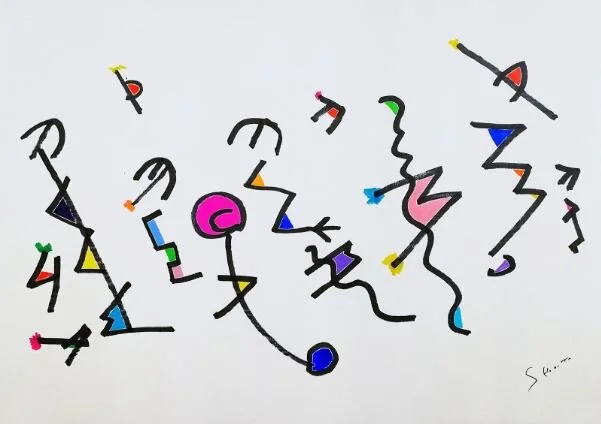Kaoru Shibuta translates musical notes into images and contemporary installations. Also, through local culture and energy of the atmosphere, he creates a poetic symphony composed of images, colors, and harmony, which is a perfect fusion between nature, music, and art.
“The world connected by sound.”
"If Mozart is the one who composes music to link the physical world to the celestial world, I am the one who undertakes him to propagate it with my painting. If Beethoven composed to surpass philosophy, then I undertake to give them a shape with my paintings. J・S・Bach is the old testament Bible of classical music."
Artist biography
Born 1980 / from Hokkaido / based in Kyoto,) 2003 Kanebo Make-up Institute, 2000 Graduated from Pan Make-up School. He grew up freely with the nature of Hokkaido, he started producing works after working as an SDF, makeup artist, plant shop, and cook. He translates music and research into paintings.
Participated in a stay production project in 2018 with the open call of the Barcelona Center for Arts and Culture Espronceda. He has made presentations at artist-in-residence locations around the world, such as the Santa Monica Museum of Art, NCCA of the Russian National Center for Contemporary Art, and Artist's Point Meghalaya. In Japan, he participated in Kyoto Re: Search, performed at RIHGA Royal Hotel Kyoto, and collaborated with local musicians to produce murals. In 2020, he won a special award at the Italian La Terraguna Prize, expanding his range of activities.
©Center for Art & Culture Espronceda
SHELTER 2020 78×100cm Acrylic, ink on paper
Ballade 2020 135×90cm Acrylic, ink on canvas
Lasya 2020 100×75cm Acrylic, ink on canvas
JEUNE HOMME 2020 130×140cm Acrylic, ink on canvas
Critic
Savina Tarsitano, artist and Co-founder Espronceda Institute of Art & Culture, Barcelona
Criticism: Savina Tarsitano, artist and Co-founder Espronceda Institute of Art & Culture, Barcelona
Over the centuries, art and music have dealt with emotions, stories, and feelings, a perfect combination where the melody and the musical notes are intertwined with the brush strokes of the artists, as in Vasilij Kandinsky and Paul Klee. During the twentieth century, there was a constant and progressive theoretical reflection on the musical dimension by important representatives of the pictorial avant-garde. There is an evolution in this relationship that leads artists to break down musical notes to create a different approach by overcoming the classicism. The young artist Shibuta immerses himself in the musical world to recreate that melody in the forms of his paintings. Over ten years, his artistic research is based on the investigation of the melody generates by nature and music. He believes in the importance of paint the music and connecting the two worlds to bring the audience in a parallel dimension. His works remind the form of Miro, like his painting “An die Freude” underlining his interest of the European art linked with a Japanese interpretation based on the concept of the aesthetics of the forms, the gaze, and nature, to create melody poetry.
Its influence derives not only from music but also from nature, from those invisible, harmonious sounds of the wind, the air, the rain, and the sun. The two worlds intertwine to create a dancing painting that expresses both the Japanese and the western tradition, as his works influenced by Bach and Beethoven, a bridge between East and West, between meditation and the aesthetics of culture Japanese for nature and shapes. Shibuta wants to create a symphony by using different techniques from acrylic to oil, tempera, Japanese sheets. In his last exhibition at Tra Transit Art Hub Osaka “Cosmically,” he showed his works that deal with music notes from Bach, Beethoven, and other artists. Each painting deals with a specific Symphony. It brings us in the musical notes as the painting “La Campanella inspired to the live performance of the pianist Ingrid Fujiko Heming where the flow of notes is melt with the rhythm of the colors. We can observe his works is a meticulous one as a musical composition where nothing is left to the chaos, but every detail has the right place, as we can see in his work “Le Nozze di Figaro.”
His works make us to reflect on our world, on the importance to listen nature, to observe those little details that help us to remember the beauty of the small things, on our culture as his work “Jeunehomme 2012-2020”
And as Karou Shibuta wrote: “If Mozart composed to link the terrestrial world to the celestial world, then I undertake to spread them with my paintings”. If Beethoven composed to surpass philosophy, then I undertake to give them a shape with my paintings.













